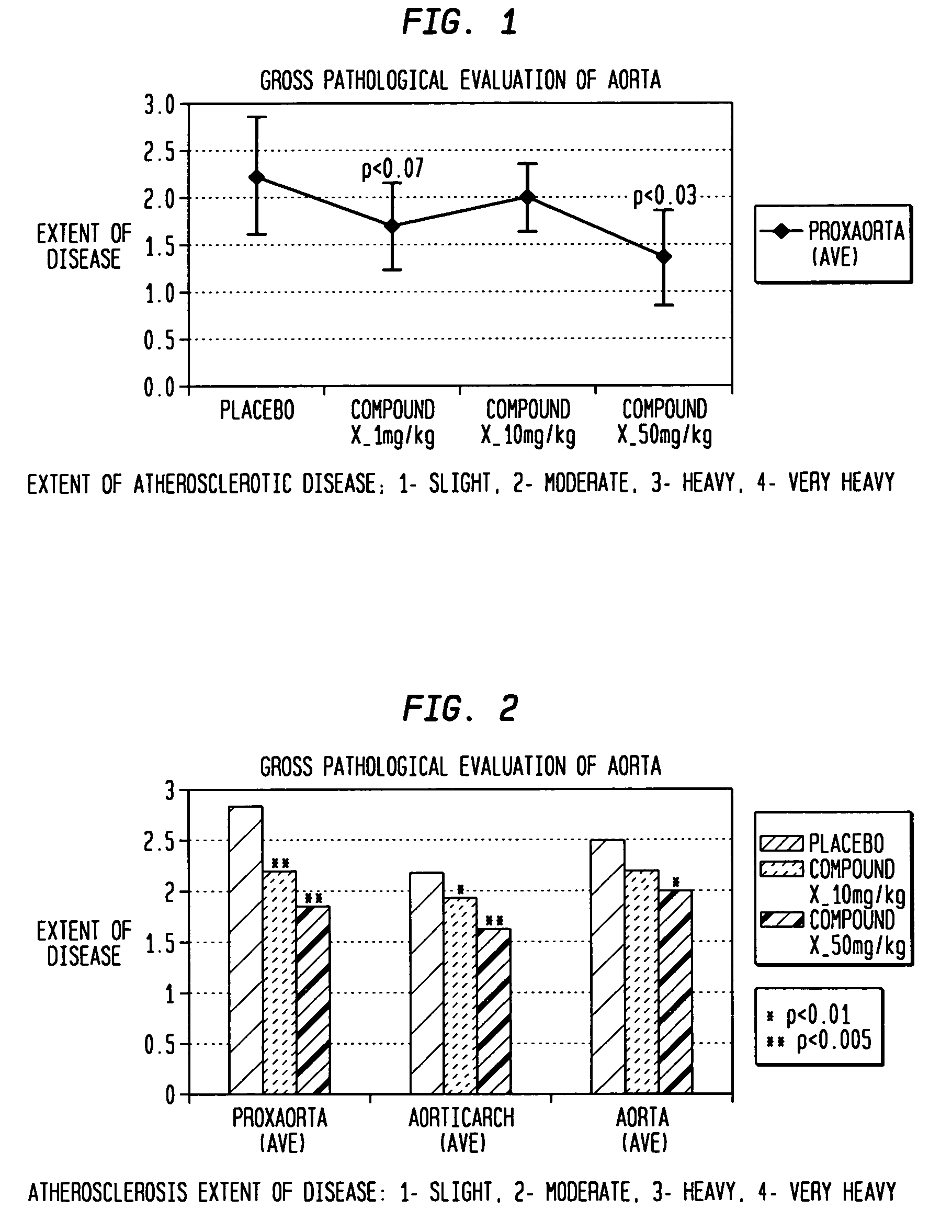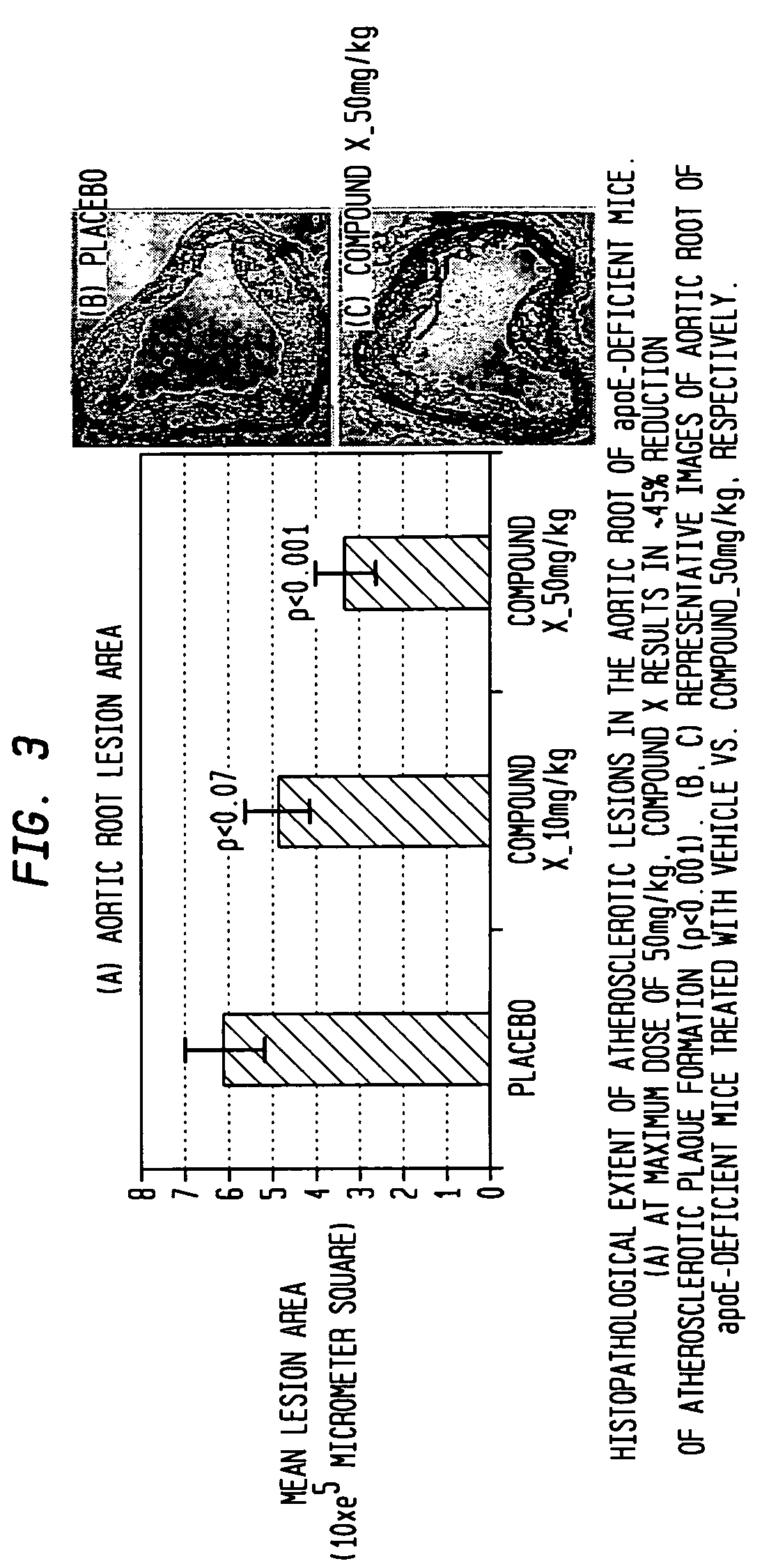Phenylalkyl N-hydroxyureas for combating atherosclerotic plaque
a technology of phenylalkyl n-hydroxyurea and atherosclerotic plaque, which is applied in the direction of biocide, drug composition, cardiovascular disorder, etc., can solve the problems of plaque rupture, clot formation, and occlusion of vessels, and achieve the effect of shortening the breath and effective combating
- Summary
- Abstract
- Description
- Claims
- Application Information
AI Technical Summary
Benefits of technology
Problems solved by technology
Method used
Image
Examples
example 1
[0057]This example was carried out on ApoE-deficient knockout mice who were before their normal development of atherosclerotic plaque which occurs in about 12 weeks to determine the effect of compound X i.e. the compound: (N-[3-[5-[(4-fluorophenyl)methyl]-2-thienyl]-1-methyl-2-propynyl]-N-hydroxyurea) on the prevention of plaque formation.
[0058]Four week old female ApoE knockout mice were fed a high fat diet (21% anhydrous milk fat and 0.15% cholesterol) for a period of eight weeks. The 12-week old ApoE-deficient mice were then randomized to receive vehicle (0.9% sterile saline administered at 5 mL / kg) or compound X and administered at three different doses: 1, 10 or 50 mg / kg, each in a volume of 5 mL / kg (from concentrations of 0.2, 2, 10 mg / mL, respectively)) daily for 28 consecutive days. Saline vehicle and doses of compound X were all prepared fresh daily and administered orally with a 22G gavage syringe. Doses were adjusted based on most recently obtained body weights.
[0059]Ther...
example 2
[0069]This example demonstrates the effect of compound X in ApoE-deficient knockout mice where atherosclerotic plaque had developed before compound X was used to treat the mice.
[0070]Four week old female ApoE-deficient knockout mice were fed a high-fat diet set forth in Example 1 for a period of 24 weeks to allow atherosclerotic plaque to build-up. The 28 week old ApoE-deficient mice were then randomized to receive vehicle (0.9% sterile saline administered at 5 mL / kg or compound X administered at two different doses, 10 mg / kg and 50 mg / kg, each in a volume of 5 mL / kg (from concentrations of 0.2 and 10 mg / L respectively) daily for 28 consecutive days. Saline vehicle and compound X were all prepared fresh daily and administered orally with a 22G gavage syringe. Doses were adjusted based on most recently obtained body weight. The following two treatment groups were tested and compared: 1) the first treatment group consisted of 20 female mice treated only with saline and 20 female mice ...
example 3
[0078]This example demonstrates the efficacy of treatment with Compound X in reducing atherosclerotic plaque and cardiovascular disease in patients. In this study the plaque levels were determined by use of Multidetector (64 slice coronary) Computerized Tomography (MDCT) scan indicative of such plaque in male and female patients suffering from Acute Coronary Syndrome (ACS). The efficacy of this treatment in reducing the effects of cardiovascular disease was determined by the use of biomarkers for this disease. For this randomized, double blind, placebo-controlled study, four groups each containing 50 clinically stable patients between the age of 30 and 80 years suffering an ACS event in the preceding twenty-one days (+ / −3 days) are treated by oral administration of Compound X.
[0079]This treatment study is carried out by Compound X being orally administered to three treatment groups, the first treatment group being at a dose of 25 mg per day. To the second treatment Group, Compound X...
PUM
| Property | Measurement | Unit |
|---|---|---|
| concentrations | aaaaa | aaaaa |
| concentrations | aaaaa | aaaaa |
| concentrations | aaaaa | aaaaa |
Abstract
Description
Claims
Application Information
 Login to View More
Login to View More - R&D
- Intellectual Property
- Life Sciences
- Materials
- Tech Scout
- Unparalleled Data Quality
- Higher Quality Content
- 60% Fewer Hallucinations
Browse by: Latest US Patents, China's latest patents, Technical Efficacy Thesaurus, Application Domain, Technology Topic, Popular Technical Reports.
© 2025 PatSnap. All rights reserved.Legal|Privacy policy|Modern Slavery Act Transparency Statement|Sitemap|About US| Contact US: help@patsnap.com



